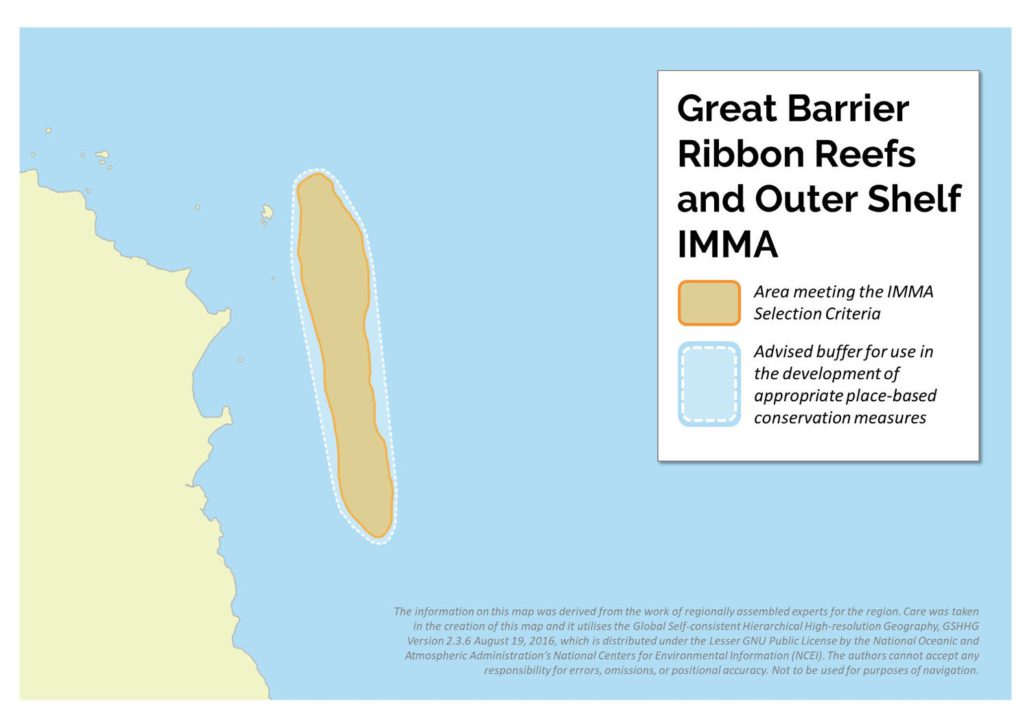Great Barrier Ribbon Reefs and Outer Shelf IMMA
Size in Square Kilometres
1,872 km2
Qualifying Species and Criteria
Dwarf minke whale – Balaenoptera acutorostrata ssp.
Criterion B (2); C (1); D (1)
Marine Mammal Diversity
Balaenoptera omurai, Megaptera novaeangliae, Pseudorca crassidens
Download factsheet
Summary
The area consists of a series of long, relatively narrow coral reefs, Ribbon Reefs #3-10, part of the northern Great Barrier Reef, northeast of Cooktown. Between late May and late August, this area supports an aggregation of dwarf minke whales, the only known regular aggregation of this subspecies in the world (Arnold et al., 1987; Arnold 1997). It is likely that this aggregation is primarily concerned with mating (Birtles et al., 2019). In addition to the winter aggregation of dwarf minke whales, there have also been a number of verified sightings of Omura’s whale in the southern end of this area in summer months (J. Meager pers. comm.). Humpback whales from the east Australian population may also be present in winter as they move throughout the Great Barrier Reef and false killer whales are also known to frequent this area.
Description of Qualifying Criteria
Criterion B: Distribution and Abundance
Sub-criterion B2: Aggregations
Dwarf minke whales have been observed at many locations in the Southern Hemisphere, usually at low latitudes, but have also been sighted around the Antarctic Peninsula, including during winter (Acevedo et al., 2011). This is the only known, regular aggregation in the world, for this subspecies and so represents an important aggregation (Birtles et al., 2014, Birtles et al., 2019). The aggregation is likely to consist of many hundreds of whales (Birtles et al., 2019). There are no global abundance data for this as of yet classified subspecies.
Criterion C: Key Life Cycle Activities
Sub-criterion C1: Reproductive Areas
Birtles et al. (2019) contend that the balance of evidence points to this aggregation being a mating aggregation, or of importance to the reproductive life cycle of the dwarf minke whale. Adults have been re-sighted repeatedly, returning to this area over several years. Young calves have been observed to accompany some females but calving may occur in deeper water adjacent to the Great Barrier Reef.
Criterion D: Special Attributes
Sub-criterion D1: Distinctiveness
This area is distinctive as it supports the only known regular aggregation of dwarf minke whales. Their behaviour here appears to be unique in that they not only aggregate, but interact readily with an active ‘swim with’ whale watching program (Valentine et al., 2004; Birtles et al., 2014, 2019). Birtles et al. (2014) report that the majority of interactions are initiated by the whales approaching people in the water.
Supporting Information
Arnold, P. W. 1997. Occurrence of dwarf minke whales (Balaenoptera acutorostrata) on the northern Great Barrier Reef, Australia. Report of the International Whaling Commission, 47, 419-424.
Arnold, P., Marsh, H. and Heinsohn, G. 1987. ‘The occurrence of two forms of minke whales in east Australian waters with a description of external characters and skeleton of the diminutive or dwarf form.’ Scientific Reports of the Whales Research Institute, 38, 1-46.
Acevedo, J., Olavarría, C., Plana, J., Aguayo-Lobo, A., Larrea, A. and Pastene, L. A. 2011. ‘Occurrence of dwarf minke whales (Balaenoptera acutorostrata subsp.) around the Antarctic Peninsula.’ Polar Biology, 34(2), 313-318.
Birtles, A., Valentine, P., Curnock, M., Mangott, A., Sobtzick, S. and Marsh, H. 2014. ‘Report to the Great Barrier Reef Marine Park Authority on the dwarf minke whale tourism monitoring program (2003-2008),’ Research Publication 112, Great Barrier Reef Marine Park Authority, Townsville; (i-xii, 60pp)
Birtles, A., Hillcoat, S., Sobtzick, S., Andrews, R., Curnock, M., Kusetic, M., Ramirez-Flores, O. and Williams, G. 2019. ‘New insights about the World’s only known, predictable winter aggregation of dwarf minke whales (Balaenoptera acutorostrata subsp.) in the remote northern Great Barrier Reef (Australia) and their implications for sustainable swim‐with‐whales management.’ Poster presented at the World Marine Mammal Conference, Barcelona, December 2019.
Valentine, P.S., Birtles, A., Curnock, M., Arnold, P. and Dunstan, A. 2004. ‘Getting closer to whales—passenger expectations and experiences, and the management of swim with dwarf minke whale interactions in the Great Barrier Reef.’ Tourism management, 25(6), 647-655.


